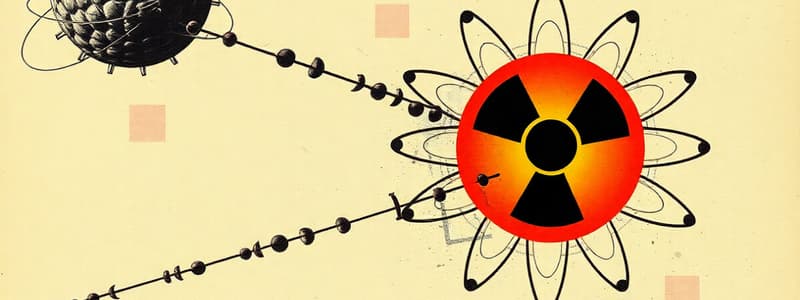Podcast
Questions and Answers
What was the prevailing model of the atom before Rutherford's experiments?
What was the prevailing model of the atom before Rutherford's experiments?
- A dense, solid sphere of uniform charge.
- A nucleus containing protons and neutrons surrounded by orbiting electrons.
- A miniature solar system with electrons orbiting a nucleus.
- A diffuse cloud of positive charge with embedded electrons. (correct)
What observation from Rutherford's gold foil experiment led him to propose a new atomic model?
What observation from Rutherford's gold foil experiment led him to propose a new atomic model?
- The gold foil became radioactive after being bombarded with alpha particles.
- The alpha particles transformed into hydrogen nuclei upon impact with the gold foil.
- Some alpha particles were deflected at large angles. (correct)
- Most alpha particles passed straight through the gold foil.
What did Rutherford discover when he bombarded elements with alpha particles?
What did Rutherford discover when he bombarded elements with alpha particles?
- Electrons were emitted from the atoms.
- Hydrogen nuclei were emitted from the atoms. (correct)
- Neutrons were emitted from the atoms.
- The atoms transformed into different elements.
What subatomic particle did James Chadwick discover?
What subatomic particle did James Chadwick discover?
What is the primary constituent of an atom's nucleus according to Rutherford's model?
What is the primary constituent of an atom's nucleus according to Rutherford's model?
How did Rutherford's model describe the atom's structure?
How did Rutherford's model describe the atom's structure?
What experimental evidence supported Rutherford's nuclear model?
What experimental evidence supported Rutherford's nuclear model?
What was the significance of the alpha particles passing straight through the gold foil?
What was the significance of the alpha particles passing straight through the gold foil?
What was Rutherford's explanation for the backward scattering of some alpha particles?
What was Rutherford's explanation for the backward scattering of some alpha particles?
What is the charge of a proton, as identified by Rutherford?
What is the charge of a proton, as identified by Rutherford?
Flashcards
Rutherford's Experiment
Rutherford's Experiment
An experiment using alpha particles to probe atomic structure.
Gold Foil Experiment
Gold Foil Experiment
An experiment showing the atom's structure via alpha particle deflection.
Atom Structure
Atom Structure
Rutherford's model describes atoms as mostly empty space with a nucleus.
Nucleus
Nucleus
Signup and view all the flashcards
Proton
Proton
Signup and view all the flashcards
Neutron
Neutron
Signup and view all the flashcards
Thomson's Model
Thomson's Model
Signup and view all the flashcards
Empty Space in Atoms
Empty Space in Atoms
Signup and view all the flashcards
Alpha Particles
Alpha Particles
Signup and view all the flashcards
Radical Shift
Radical Shift
Signup and view all the flashcards
Study Notes
Rutherford's Atomic Model
- Rutherford's work in 1902 challenged existing chemical understanding of atomic structure
- He famously fired positively charged particles at a thin sheet of gold foil
- Most particles passed straight through, but some were deflected or bounced back
- This led Rutherford to conclude that atoms are mostly empty space, with a dense, positively charged nucleus at the center
- The positively charged nucleus contained most of the atom's mass
Atomic Structure
- Thomson's plum pudding model: a model of the atom with electrons embedded within a positively charged 'pudding'
- Rutherford's model introduced the concept of a nucleus, containing most of the atom's mass and positive charge
- Electrons orbit the nucleus
- This model revolutionized understanding of matter at the atomic level
Radioactive Decay
- Atoms disintegrate when releasing particles
- Radiation is a byproduct of this process
- Radioactive materials disintegrate at different rates, measured by their half-lives
Atomic Nucleus
- Rutherford discovered that the positive charge and mass of the atom are concentrated within a very small volume, at the center of the atom
- He called this central region the "nucleus"
Proton Discovery
- Rutherford concluded that hydrogen nuclei (protons) are fundamental building blocks of all elements
- Hydrogen atoms are the simplest
- Bombarding other light elements with alpha particles releases hydrogen nuclei
- Protons were postulated to have a positive charge, located in the atomic nucleus
Neutron Discovery
- Neutral particles (neutrons), also found within the nucleus, were identified by James Chadwick in 1932
Studying That Suits You
Use AI to generate personalized quizzes and flashcards to suit your learning preferences.




